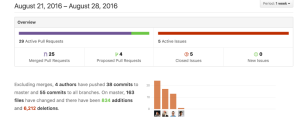
Velocity Metrics to Drive Growth
Introduction to Velocity Metrics
In today’s fast-paced business environment, companies are constantly seeking ways to improve their processes and drive growth. One effective strategy is the use of velocity metrics, which provide valuable insights into the efficiency and productivity of teams. Velocity metrics, often used in agile methodologies, measure the rate at which work is completed and help teams identify bottlenecks, optimize productivity, and ultimately achieve their goals.
VELOCITY METRICS THAT YOU NEED YO KNOW
Why Velocity Metrics are Important for Driving Growth
Velocity metrics play a crucial role in driving growth for organizations. By tracking the speed and efficiency of work, teams can identify areas of improvement and take necessary actions to optimize their processes. Moreover, velocity metrics provide valuable data that can be used to set realistic goals, allocate resources effectively, and make informed decisions. By continuously monitoring and analyzing velocity metrics, organizations can ensure that they are on the right track towards achieving their growth objectives.
Common Velocity Metrics used in Agile Methodologies
Agile methodologies, such as Scrum, rely heavily on velocity metrics to measure the progress of development teams. One commonly used velocity metric is the agile metrics velocity, which calculates the number of user stories or features completed within a given time frame. This metric helps teams understand their capacity and plan future iterations more accurately. Another important velocity metric is the flow velocity, which measures the time it takes for a work item to move through the development process. This metric helps teams identify bottlenecks and optimize their workflow for faster delivery.
What Does Team Velocity Measure?
Team velocity is a velocity metric that measures the amount of work completed by a team in a given time period. It takes into account factors such as team size, complexity of tasks, and available resources. Team velocity provides valuable insights into the capacity and efficiency of a team, allowing organizations to plan future sprints or iterations more effectively. By analyzing team velocity over time, organizations can identify trends and make data-driven decisions to improve team performance and drive growth.
Is Velocity a KPI?
Velocity is often debated as a key performance indicator (KPI) in agile methodologies. While velocity provides valuable insights into team performance and productivity, it is important to note that it should not be the sole metric used to evaluate success. Velocity should be used in conjunction with other KPIs, such as customer satisfaction, on-time delivery, and quality metrics, to get a holistic view of team performance. By considering multiple KPIs, organizations can better assess the overall success and impact of their development efforts.
Key Performance Indicators (KPIs) for Measuring Velocity
To measure velocity effectively, organizations should consider using a combination of KPIs that align with their goals and objectives. Some key performance indicators for measuring velocity include:
1. Sprint or iteration velocity: This metric measures the amount of work completed by a team in a single sprint or iteration. It provides insights into the team’s capacity and helps with future planning.
2. Cycle time: Cycle time measures the time it takes for a work item to move through the development process. By reducing cycle time, teams can deliver value to customers more quickly.
3. Throughput: Throughput measures the rate at which work is completed. It helps teams identify bottlenecks and optimize their processes for faster delivery.
4. Lead time: Lead time measures the time it takes for a work item to go from request to delivery. By reducing lead time, teams can improve customer satisfaction and deliver value more efficiently.
By tracking these KPIs and analyzing the data, organizations can gain valuable insights into their velocity and make data-driven decisions to drive growth.

Development Velocity Metrics
Development velocity metrics, firstly, focus on the efficiency and productivity of development teams. Subsequently, these metrics play a crucial role in helping organizations optimize their development processes, ensuring the timely delivery of high-quality software. Furthermore, among the various development velocity metrics, the development velocity metric stands out as particularly significant. This metric specifically measures the speed at which engineering tasks are completed. Consequently, it offers valuable insights into the overall productivity of development teams, serving as a powerful tool for organizations to identify specific areas for improvement.
Flow Velocity Metrics in Software Development
Flow velocity metrics are essential in the context of monitoring and optimizing the flow of work in software development. These metrics specifically measure the time it takes for a work item to progress through various stages of development, spanning from ideation to delivery. Consequently, by actively tracking flow velocity, teams gain the ability to pinpoint bottlenecks, streamline their processes, and ensure a smooth and efficient workflow. In addition to this, flow velocity metrics offer valuable insights into the overall efficiency of development teams. This, in turn, empowers organizations to drive growth by enhancing their capacity to deliver software faster and more effectively.
Engineering Velocity Metrics
In addition to agile metrics, engineering velocity metrics are also crucial for driving growth in software development. These metrics focus on the efficiency of engineering processes and help teams identify areas for improvement. One key engineering velocity metric is the software velocity metric, which measures the speed at which software is developed and released. This metric provides insights into the productivity of development teams and helps organizations track their progress towards meeting project deadlines.
Engineering Velocity Metrics for Optimizing Productivity
Engineering velocity metrics focus on the productivity and efficiency of engineering processes. These metrics help organizations optimize their engineering practices and drive growth. One key engineering velocity metric is the software velocity metric, which measures the speed at which software is developed and released. By monitoring software velocity, organizations can identify areas for improvement, optimize their development processes, and ensure timely delivery of high-quality software.
Best Practices for Using Velocity Metrics Effectively
To effectively use velocity metrics for driving growth, organizations should consider the following best practices:
1. Set realistic goals: Use velocity metrics to set realistic goals and expectations for teams. Ensure that goals are achievable and aligned with organizational objectives.
2. Continuously monitor and analyze velocity metrics: Regularly track and analyze velocity metrics to identify trends, bottlenecks, and areas for improvement. Use this data to make informed decisions and drive growth.
3. Use velocity metrics in conjunction with other KPIs: Velocity metrics should not be used in isolation. Consider using other KPIs, such as customer satisfaction and quality metrics, to gain a holistic view of team performance.
4. Foster a culture of continuous improvement: Encourage teams to continuously improve their processes and productivity. Provide support and resources for implementing changes based on velocity metrics.
By following these best practices, organizations can leverage velocity metrics effectively to drive growth and achieve their goals.

Agile Metrics Velocity: Measuring Progress
One of the key velocity metrics in agile methodologies is the measurement of progress. Agile teams often use velocity as a performance indicator to gauge how much work they can complete in a given time frame. Velocity is calculated by summing up the number of story points or units of work completed during a sprint. This metric allows teams to estimate how much work they can deliver in future sprints and plan accordingly.
To calculate velocity, the team needs to track the number of story points completed in each sprint and divide it by the number of sprints. For example, if a team completes 20 story points in a two-week sprint, their velocity would be 10 story points per sprint. By monitoring and analyzing this metric over time, teams can identify trends, monitor progress, and make informed decisions to improve their performance.
Agile Metrics Velocity Formula: Unleashing Efficiency
The formula for calculating velocity in agile methodologies is quite straightforward. It involves dividing the total number of story points completed by the number of sprints. The resulting number represents the average velocity of the team. By using this formula, teams can accurately measure their productivity and track improvements over time.
It’s important to note that velocity is not a measure of individual performance but rather a team metric. It helps teams understand their collective capacity and guides them in planning and prioritizing work. By focusing on increasing velocity, teams can improve their efficiency and deliver more value to their stakeholders.
Burndown Chart and Velocity in Agile: Visualizing Progress
A burn down chart is a visual representation of a team’s progress over time. It shows the remaining work versus the time left in a sprint. Velocity plays a significant role in burn down charts as it helps teams estimate how much work they can complete within a sprint. By comparing the actual progress with the ideal progress represented by the burn down line, teams can identify if they are on track to meet their goals.
The burn down chart also provides insights into the team’s velocity. If the actual progress consistently falls below the ideal line, it may indicate that the team’s velocity is lower than expected. On the other hand, if the actual progress consistently exceeds the ideal line, it may suggest that the team’s velocity is higher than expected. By analyzing these patterns, teams can make adjustments to their planning and optimize their work processes.
Safe Team Velocity: Balancing Capacity and Demand
In the Scaled Agile Framework (SAFe), the concept of team velocity is slightly different from traditional agile methodologies. SAFe teams focus on balancing capacity and demand to ensure a smooth flow of work. Velocity in SAFe is defined as the number of story points a team can complete in a given iteration, considering their available capacity.
SAFe teams also consider the concept of velocity range, which accounts for variations in team performance due to external factors. The velocity range helps teams set realistic expectations and plan their work accordingly. By monitoring their velocity range, SAFe teams can identify potential risks and take proactive measures to mitigate them.
What is the Difference Between Velocity and Capacity in SAFe?
While velocity and capacity are both important metrics in SAFe, they represent different aspects of a team’s performance. Capacity refers to the amount of work a team can handle in a given time frame, taking into account factors such as team size, individual skills, and availability. It is a measure of the team’s potential output.
Velocity, on the other hand, represents the team’s actual output or productivity. It is calculated based on the number of story points completed in each iteration. Velocity takes into account not only the team’s capacity but also their efficiency and effectiveness in delivering value.
Understanding the difference between velocity and capacity is crucial in SAFe as it helps teams set realistic expectations, balance their workload, and optimize their performance.

Velocity Metrics in Scrum Methodology: Driving Continuous Improvement
In Scrum methodology, velocity metrics play a vital role in driving continuous improvement. Scrum teams measure their velocity to understand their capacity and predict how much work they can complete in future sprints. This metric helps teams plan their backlog and set realistic goals.
However, it’s important to note that velocity is not a fixed measure. It can vary from sprint to sprint due to factors such as team dynamics, complexity of work, and external dependencies. By monitoring their velocity over time, Scrum teams can identify trends, improve their estimation accuracy, and make data-driven decisions to enhance their performance.
Scrum Velocity Chart: Tracking Progress
A Scrum velocity chart is a graphical representation of a team’s velocity over time. It helps teams visualize their performance and track their progress sprint by sprint. The chart plots the team’s velocity for each completed sprint and provides insights into their overall trend.
Analyzing the Scrum velocity chart allows teams to identify any fluctuations or patterns in their performance. It helps them understand the factors that influence their velocity and make informed decisions to optimize their work processes. By continuously monitoring their velocity chart, Scrum teams can drive growth and deliver consistent value to their stakeholders.
What is the Difference Between Velocity and Productivity in Scrum?
While velocity and productivity are related metrics in Scrum, they represent different aspects of a team’s performance. Velocity measures the amount of work completed by the team in a given time frame, usually measured in story points. It provides insights into the team’s speed and efficiency.
Productivity, on the other hand, focuses on the team’s output in terms of value delivered. It takes into account not only the quantity of work completed but also the quality and impact of that work. Productivity metrics help teams understand how effectively they are delivering value to their stakeholders.
By tracking both velocity and productivity, Scrum teams can gain a comprehensive understanding of their performance and identify areas for improvement. Balancing these metrics ensures that the team is not only delivering work at a high speed but also delivering valuable outcomes.
Sprint Velocity Metrics: Optimizing Sprint Planning
Sprint velocity metrics are crucial for optimizing sprint planning in Scrum. By analyzing the team’s velocity from previous sprints, Scrum teams can estimate how much work they can commit to in upcoming sprints. This helps them set realistic goals, manage stakeholder expectations, and ensure a steady flow of value delivery.
Sprint velocity metrics also enable teams to identify any bottlenecks or inefficiencies in their work processes. If the team’s velocity is consistently lower than expected, it may indicate the need for process improvements or resource allocation adjustments. By addressing these issues, teams can increase their velocity and drive growth.
Tools and Software for Tracking Velocity Metrics
Several tools and software are available to help teams track and analyze velocity metrics effectively. One popular tool is JIRA, a project management software that provides features specifically designed for agile teams. JIRA allows teams to track and visualize their velocity metrics, manage their backlog, and collaborate seamlessly.
Other tools like Trello, and velocity metrics Azure DevOps also offer capabilities for tracking velocity metrics and managing agile projects. These tools provide dashboards, reporting features, and integrations with other software, making it easier for teams to monitor and optimize their performance.
Choosing the right tool for tracking velocity metrics depends on the specific needs and preferences of your team. It’s important to evaluate different options and select a tool that aligns with your organization’s goals and processes.
Conclusion and Next Steps for Implementing Velocity Metrics
Velocity metrics are powerful tools for driving growth and optimizing team performance. By measuring and analyzing velocity, teams can identify areas for improvement, optimize their work processes, and deliver more value to their stakeholders.
To implement velocity metrics effectively, it’s important to:
1. Educate your team on the importance and benefits of velocity metrics.
2. Establish a consistent and accurate process for tracking and calculating velocity.
3. Incorporate velocity metrics into your regular sprint planning and retrospective meetings. 4. Continuously monitor and analyze velocity metrics to identify trends and make data-driven decisions. 5. Experiment with different strategies and techniques to optimize your team’s velocity.
By following these steps and leveraging velocity metrics, you can drive growth, improve team performance, and achieve your organization’s goals. Implement velocity metrics today and unlock the full potential of your team!
IT METRICS TO BECOME AN EXPERT




























Leave a Reply